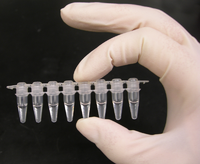
Photo from wikipedia
Purpose As of June 30, 2021, WHO reported 181,344,224 confirmed cases worldwide and 3,934,252 deaths due to SARS CoV-2. India accounts almost 10% of the total mortality. The mutated Variants… Click to show full abstract
Purpose As of June 30, 2021, WHO reported 181,344,224 confirmed cases worldwide and 3,934,252 deaths due to SARS CoV-2. India accounts almost 10% of the total mortality. The mutated Variants of Concern (VoC) and Variants of Interest (VoI) has acquired non-synonymous amino acid substitutions in Spike (S), ORF1a, ORF1b, Nucleocapsid (N), Membrane (M), Envelope (E), ORF6, ORF7a, ORF3a and ORF8 regions exhibiting more virulence and higher transmission rate. The S gene displaying nucleotide polymorphisms are studied for identification of major SARS CoV-2 variants circulating in India using in silico PCR-RFLP analysis. Methods & Materials DNA sequences of major SARS CoV-2 variants [alpha (B.1.1.7), beta (B.1.351), delta (B.1.617.2), epsilon (B.1.429+B.1.427), eta (B.1.525) and zeta (P.2)] prevailing in India retrieved from GISAID database were annotated using VIPR-VIGOR4 genome annotator tool. The S gene of variants were aligned using CLUSTALW algorithm in MEGA-X with default parameters and analyzed for sequence identity using Geneious Prime v2019.2.1. Primers were designed using Primer-BLAST tool, proof-read using FastPCR v6.7.46 and PCR-amplified using Snapgene v.3.2.1. Unique restriction sites in S amplicons of each variant were subjected to online Restriction Analyzer tool. The S amplicons were digested with restriction endonucleases and the band profile of each variant were visualized in the gel simulation tool using Snapgene v.3.2.1. Results The percentage of identical sites present in S region among SARS CoV-2 variants was found to be 98.6%. The amplified products were in the length of 3,689 and 3,698 bp. Out of 400 restriction endonucleases identified, 14 buffer-compatible enzymes were selected for single-step restriction digestion to generate unique RFLP profiles for each variant. The BsaXI-XcmI-AcuI triple digest showed unique banding pattern identifiers on 2% agarose gel for individual variants including alpha, eta, delta and zeta. The ApaLI-BsaI double digest produced distinct band profiles for beta and epsilon variants. Conclusion Our study strongly suggests PCR-RFLP analysis of Spike region can differentiate major SARS CoV-2 variants that are circulating in India. Further, quadruple digestion based wet lab experiments are underway to explore the possibility of surveillance of the major variants using a single-tube reaction followed by agarose gel-based profiling.
Journal Title: International Journal of Infectious Diseases
Year Published: 2022
Link to full text (if available)
Share on Social Media: Sign Up to like & get
recommendations!